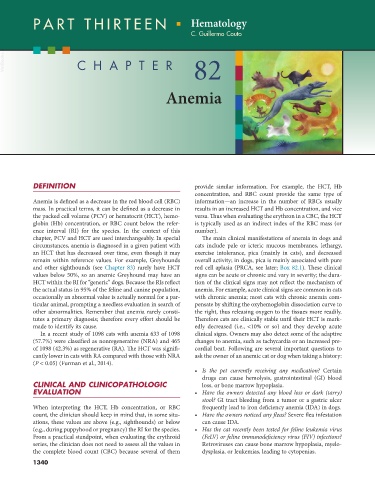Page 1368 - Small Animal Internal Medicine, 6th Edition
P. 1368
PART THIRTEEN Hematology
1340
PART XIII Hematology
C. Guillermo Couto
VetBooks.ir CHAPTER 82
Anemia
DEFINITION provide similar information. For example, the HCT, Hb
concentration, and RBC count provide the same type of
Anemia is defined as a decrease in the red blood cell (RBC) information—an increase in the number of RBCs usually
mass. In practical terms, it can be defined as a decrease in results in an increased HCT and Hb concentration, and vice
the packed cell volume (PCV) or hematocrit (HCT), hemo- versa. Thus when evaluating the erythron in a CBC, the HCT
globin (Hb) concentration, or RBC count below the refer- is typically used as an indirect index of the RBC mass (or
ence interval (RI) for the species. In the context of this number).
chapter, PCV and HCT are used interchangeably. In special The main clinical manifestations of anemia in dogs and
circumstances, anemia is diagnosed in a given patient with cats include pale or icteric mucous membranes, lethargy,
an HCT that has decreased over time, even though it may exercise intolerance, pica (mainly in cats), and decreased
remain within reference values. For example, Greyhounds overall activity; in dogs, pica is mainly associated with pure
and other sighthounds (see Chapter 83) rarely have HCT red cell aplasia (PRCA, see later; Box 82.1). These clinical
values below 50%, so an anemic Greyhound may have an signs can be acute or chronic and vary in severity; the dura-
HCT within the RI for “generic” dogs. Because the RIs reflect tion of the clinical signs may not reflect the mechanism of
the actual status in 95% of the feline and canine population, anemia. For example, acute clinical signs are common in cats
occasionally an abnormal value is actually normal for a par- with chronic anemia; most cats with chronic anemia com-
ticular animal, prompting a needless evaluation in search of pensate by shifting the oxyhemoglobin dissociation curve to
other abnormalities. Remember that anemia rarely consti- the right, thus releasing oxygen to the tissues more readily.
tutes a primary diagnosis; therefore every effort should be Therefore cats are clinically stable until their HCT is mark-
made to identify its cause. edly decreased (i.e., <10% or so) and they develop acute
In a recent study of 1098 cats with anemia 633 of 1098 clinical signs. Owners may also detect some of the adaptive
(57.7%) were classified as nonregenerative (NRA) and 465 changes to anemia, such as tachycardia or an increased pre-
of 1098 (42.3%) as regenerative (RA). The HCT was signifi- cordial beat. Following are several important questions to
cantly lower in cats with RA compared with those with NRA ask the owner of an anemic cat or dog when taking a history:
(P < 0.05) (Furman et al., 2014).
• Is the pet currently receiving any medication? Certain
drugs can cause hemolysis, gastrointestinal (GI) blood
CLINICAL AND CLINICOPATHOLOGIC loss, or bone marrow hypoplasia.
EVALUATION • Have the owners detected any blood loss or dark (tarry)
stool? GI tract bleeding from a tumor or a gastric ulcer
When interpreting the HCT, Hb concentration, or RBC frequently lead to iron deficiency anemia (IDA) in dogs.
count, the clinician should keep in mind that, in some situ- • Have the owners noticed any fleas? Severe flea infestation
ations, these values are above (e.g., sighthounds) or below can cause IDA.
(e.g., during puppyhood or pregnancy) the RI for the species. • Has the cat recently been tested for feline leukemia virus
From a practical standpoint, when evaluating the erythroid (FeLV) or feline immunodeficiency virus (FIV) infections?
series, the clinician does not need to assess all the values in Retroviruses can cause bone marrow hypoplasia, myelo-
the complete blood count (CBC) because several of them dysplasia, or leukemias, leading to cytopenias.
1340

